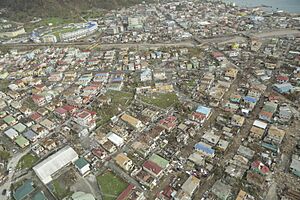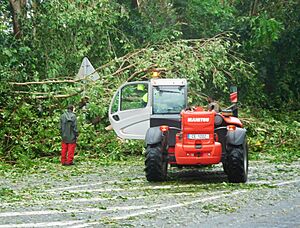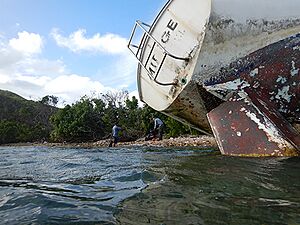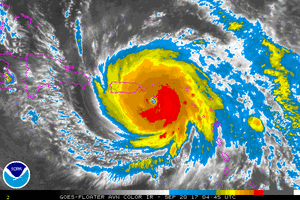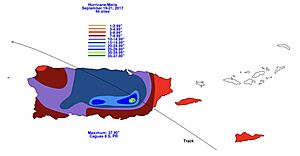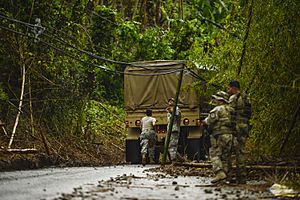Hurricane Maria facts for kids
Hurricane Maria was an extremely powerful Category 5 hurricane that caused massive destruction in the Caribbean in September 2017. It was the strongest storm of the very active 2017 Atlantic hurricane season.
The hurricane caused the most damage on the island of Dominica and the U.S. territory of Puerto Rico. It is the worst natural disaster in the history of both islands. Sadly, the storm led to the deaths of 3,059 people, with most of those deaths occurring in Puerto Rico.
The total cost of the damage was more than $91 billion, making it one of the costliest hurricanes ever recorded. Because the storm was so destructive, the name Maria was retired and will never be used for an Atlantic hurricane again.
Contents
The Storm's Path and Strength
Maria started as a tropical wave off the coast of Africa on September 12, 2017. As it moved west across the warm Atlantic Ocean, it quickly grew stronger. On September 16, it became Tropical Storm Maria.
The storm then went through a period of what scientists call "explosive intensification," meaning it got stronger very, very quickly. In just 24 hours, it grew from a Category 1 hurricane to a powerful Category 5 hurricane.
On September 18, Maria made landfall on the island of Dominica with winds of 165 mph (266 km/h). It was the first Category 5 hurricane ever to hit the island.
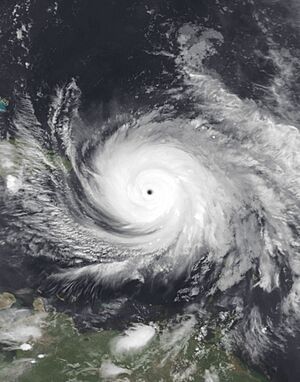
After hitting Dominica, Maria weakened slightly but quickly regained its strength in the Caribbean Sea. It reached its peak power on September 20, with winds of 175 mph (282 km/h). Later that day, it made landfall in Puerto Rico as a high-end Category 4 hurricane with winds of 155 mph (249 km/h). It was the strongest hurricane to hit Puerto Rico since 1928.
The storm weakened as it crossed Puerto Rico's mountains. It then moved north, passing near the Dominican Republic and the Bahamas before heading out into the open Atlantic. It slowly lost strength and eventually faded away by October 2.
Getting Ready for the Storm
As Maria approached the Caribbean, governments issued warnings to help people prepare. In places like Martinique, Guadeloupe, and Dominica, people were told to expect a major storm. Hurricane watches were also issued for the U.S. and British Virgin Islands.
Puerto Rico
In Puerto Rico, people were still recovering from Hurricane Irma, which had passed by just two weeks earlier. About 80,000 people were already without electricity when Maria approached.
The government issued evacuation orders and opened 450 shelters for people who needed a safe place to stay. By the time the storm hit, over 2,000 people had moved into these shelters.
The Hurricane's Impact
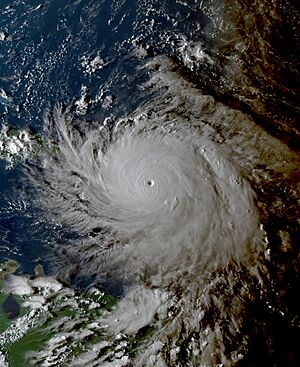
Hurricane Maria near its strongest point on September 19, 2017, as it moved toward Puerto Rico.
|
|
| Meteorological history | |
|---|---|
| Formed | September 16, 2017 |
| Extratropical | September 30, 2017 |
| Dissipated | October 2, 2017 |
| Category 5 tropical cyclone | |
| 1-minute sustained (SSHWS/NWS) | |
| Highest winds | 175 mph (280 km/h) |
| Lowest pressure | 908 mbar (hPa); 26.81 inHg |
| Overall effects | |
| Fatalities | 3,059 total |
| Damage | $91.6 billion (2017 USD) (Fourth-costliest tropical cyclone on record; costliest in Dominican and Puerto Rican history) |
| Areas affected |
|
| Territory | Fatalities | Missing | Damage (2017 USD) |
Ref |
|---|---|---|---|---|
| Dominica | 65 | 0 | $1.37 billion | |
| Dominican Republic | 5 | 1 | $63 million | |
| Guadeloupe (France) | 4 | 0 | $120 million | |
| Haiti | 3 | 0 | N/A | |
| Martinique (France) | 0 | 0 | $42 million | |
| Saint Kitts and Nevis | 0 | 0 | $12.8 million | |
| Puerto Rico | 2,975 | 60 | $90 billion | |
| United States Virgin Islands | 3 | 4 | ||
| United States | 4 | 0 | N/A | |
| Totals: | 3,059 | 65 | $91.6 billion |
Dominica
When Maria hit Dominica as a Category 5 hurricane, it caused unbelievable damage. The powerful winds tore the roofs off nearly every building on the island, including the home of the Prime Minister, Roosevelt Skerrit.
The storm knocked out all communication, cutting Dominica off from the rest of the world. For days, no one knew how bad the situation was. When the first pictures emerged, they showed an island that was almost completely destroyed. Houses were flattened, roads were blocked by landslides, and the island's lush green rainforests were stripped bare.
The country's farming industry was wiped out. All of the island's 73,000 residents were affected. Sadly, 65 people lost their lives. The Prime Minister called the damage "mind-boggling."
Guadeloupe
The nearby island of Guadeloupe also felt Maria's power. Strong winds and heavy rain caused flooding and damaged buildings. Many roads were blocked by fallen trees.
The storm left 80,000 homes without electricity. It also destroyed most of the island's banana crops, which was a major blow to local farmers.
U.S. Virgin Islands
The U.S. Virgin Islands, which had already been hit by Hurricane Irma, were struck again by Maria. The island of Saint Croix was hit the hardest.
Winds of over 100 mph damaged buildings and knocked out power. The storm caused severe damage across the island, and it took almost a year for electricity to be restored to everyone.
Puerto Rico
The impact on Puerto Rico was catastrophic. The entire island, home to 3.4 million people, lost electricity. This caused the largest blackout in American history.
Heavy rain caused massive flooding and landslides all over the island. Rivers overflowed their banks, and some towns were trapped under 15 feet of water. Thousands of people had to be rescued from their homes.
Communication systems were also destroyed. Most people had no phone or internet service, making it hard to call for help or contact family. The governor of Puerto Rico, Ricardo Rosselló, said it could take months to restore power. For some people, it took almost a year.
The storm destroyed tens of thousands of homes and wiped out about 80% of the island's crops. The famous Arecibo Observatory was also damaged when a large antenna broke and fell onto the main dish.
The Aftermath and Recovery
Dominica
After the storm, the people of Dominica faced a huge challenge. With most homes damaged or destroyed, many were left homeless. There were shortages of food and clean water.
Help came from other countries and organizations. The United States, Canada, and other Caribbean nations sent ships with supplies and rescue teams. The recovery was slow, but the people of Dominica worked hard to rebuild their country.
Puerto Rico
| Rank | Hurricane | Season | Damage | ||
|---|---|---|---|---|---|
| 1 | Katrina | 2005 | $108 billion | ||
| 2 | Sandy | 2012 | $71.4 billion | ||
| 3 | Ike | 2008 | $29.5 billion | ||
| 4 | Andrew | 1992 | $26.5 billion | ||
| 5 | Wilma | 2005 | $21 billion | ||
| 6 | Ivan | 2004 | $18.8 billion | ||
| 7 | Irene | 2011 | $15.6 billion | ||
| 8 | Charley | 2004 | $15.1 billion | ||
| 9 | Rita | 2005 | $12 billion | ||
| 10 | Frances | 2004 | $9.51 billion | ||
| Source: National Hurricane Center | |||||
The situation in Puerto Rico was a major humanitarian crisis. With no power, clean water, or communication, life was extremely difficult for millions of people.
The U.S. government declared the entire island a Federal Disaster Zone. The Federal Emergency Management Agency (FEMA), along with the U.S. military, began a massive relief effort. They sent ships and planes with food, water, generators, and other supplies.
The recovery was very slow and difficult. One of the biggest challenges was repairing the power grid. For months, many people lived without electricity. Hospitals had to rely on backup generators. The lack of power also made it hard to get clean water to everyone.
Many schools were closed for a long time. Because of the difficult conditions, hundreds of thousands of people left Puerto Rico and moved to the mainland United States.
Even years later, Puerto Rico was still working to recover from the storm. The hurricane showed how vulnerable the island's infrastructure was and led to calls for building a stronger, more resilient power grid.
See also
 In Spanish: Huracán María para niños
In Spanish: Huracán María para niños
- List of the deadliest tropical cyclones
- List of disasters by cost
- Tropical cyclones and climate change


